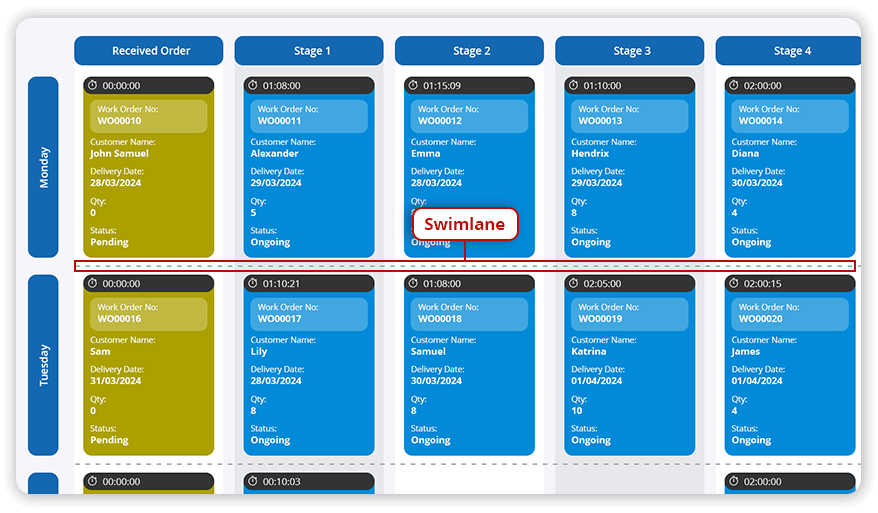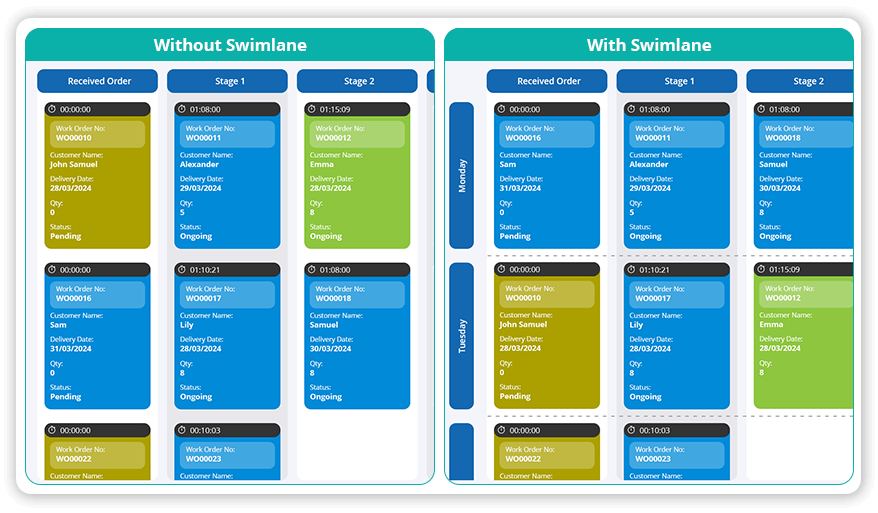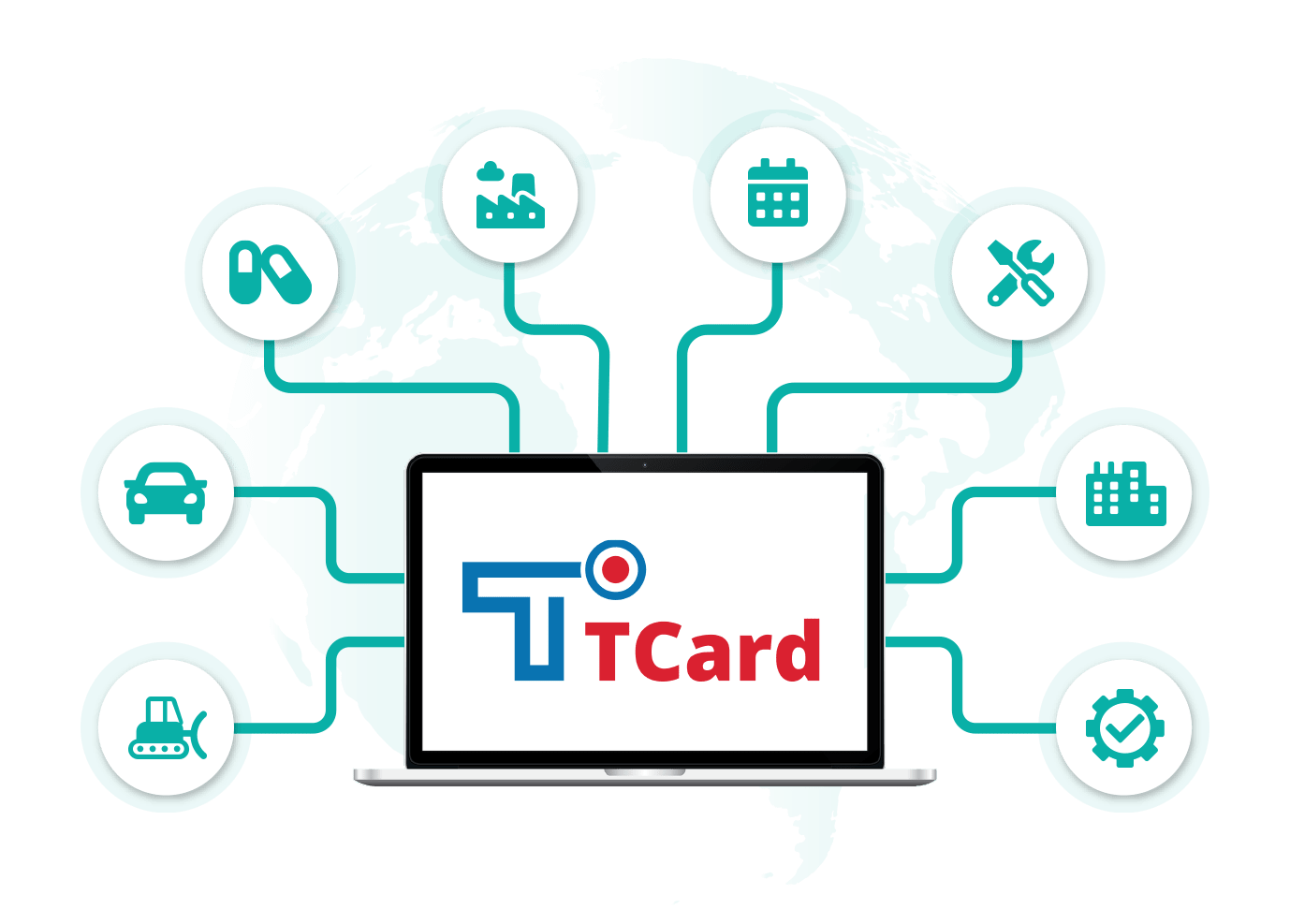What are Kanban Swimlanes?
Kanban swimlanes visually segregate work items by stages or teams, facilitating clear workflow tracking, enhancing communication between different departments.
Start Free Trial Watch VideoContents
- What are Kanban Swimlanes?
- Types of Kanban Swimlanes
- What is the relationship between the Kanban board and Swimlanes?
- How many Swimlanes can you insert on a Kanban Board?
- What is the process of Swimlane?
- Why should you use a Kanban board with Swimlanes?
- Best practices for mastering the use of Swimlanes in a Kanban Board
- How do Swimlanes align with the principles of Visual Management in Kanban?
- Kanban-Swimlanes-vs-Swimlane-Flowcharts
- Examples of categorisation using Kanban Swimlanes
What are Kanban Swimlanes?

In Kanban boards, swimlanes are horizontal divisions or lanes that categorise or organise the workflow based on specific criteria. Swimlanes provide a visual way to manage homogenous tasks or work items. By dividing the board using swimlanes, teams can easily visualise and manage work items, track progress, and prioritise tasks effectively.
Key Features of Kanban Swimlanes
- Categorisation: Swimlanes categorise work items into different groups or segments based on predefined criteria, such as project type, department, or priority.
- Visualisation: Swimlanes visually represent work distribution and progress within the Kanban board, offering clarity and transparency to team members and stakeholders.
- Organisation: Swimlanes help organise tasks and activities within the Kanban workflow, making it easier to manage and prioritise work items according to their respective categories or stages.
- Customisation: Kanban swimlanes allow teams to tailor their Kanban boards to specific workflow requirements and preferences. With customisation options, users can define swimlane categories, organise tasks based on teams or projects and adjust swimlane layouts to optimise visual clarity and efficiency.
Types of Kanban Swimlanes
-
Team-Based Swimlanes
- Organise tasks according to different teams or departments within the organisation.
- Enhance collaboration and coordination among team members.
- Assign ownership and accountability for tasks within each team.
-
Project-Based Swimlanes
- Categorise tasks based on distinct projects or initiatives.
- Helps in project management by providing a clear project or task progress overview.
- Streamline communication and decision-making within project teams.
-
Priority-Based Swimlanes
- Prioritise tasks based on urgency, importance, or criticality.
- Ensure that high-priority items receive prompt attention and action.
- Help teams focus on the most impactful work to achieve organisational goals.
-
Department-Based Swimlanes
- Segment tasks according to different departments or functional areas within the organisation.
- Improve visibility and understanding of department-specific workloads and priorities.
- Foster collaboration and alignment across different departments or business units.
-
Issue-Type Swimlanes
- Classify tasks based on the issue they represent, such as bugs, enhancements, or feature requests.
- Streamline issue resolution processes by categorising and prioritising tasks according to their nature.
- Ensure that different types of issues receive appropriate attention and resolution.
-
Customer-Specific Swimlanes
- Group tasks based on specific customer requirements, projects, or contracts.
- Tailor workflows and priorities to meet the needs and expectations of individual customers.
- Enhance customer satisfaction by providing personalised attention and service.
-
Time-Based Swimlanes
- Divide tasks into time intervals, such as daily, weekly, or monthly swimlanes.
- Schedule and track work activities over specific periods to meet deadlines and milestones.
- Improve time management and resource allocation by visualising workloads and timelines effectively.
What is the relationship between the Kanban board and Swimlanes?
Swimlanes is one of the structures within the Kanban board used for categorisation. The Kanban board serves as a visual representation of tasks or work items, typically organised into columns representing different workflow stages. On the other hand, Swimlanes provide an additional layer of segmentation by dividing the Kanban board horizontally. Each swimlane represents a category or division, such as departments, teams, projects, or stages of a process. By incorporating swimlanes into the Kanban board, teams can effectively group and manage tasks based on various criteria, enhancing clarity and workflow management.
How many Swimlanes can you insert on a Kanban Board?
You can add as many swimlanes as needed to a Kanban board to effectively organise tasks and visualise workflow stages. The flexibility of Kanban board allows users to create swimlanes based on different criteria, such as teams, projects, priorities, or workflow stages. By utilising multiple swimlanes, teams can streamline task management, prioritise work items, and gain a comprehensive workflow overview, facilitating better decision-making and collaboration across the organisation.
What is the process of Swimlane?
Adding swimlanes to a Kanban board can be done in a few simple steps:
- Identify Swimlane Categories: Begin by identifying the categories or divisions you wish to establish within your swimlane. These categories can encompass departments, teams, projects, workflow stages, or other relevant factors essential for efficient task organisation.
- Create Swimlanes: Generate horizontal divisions on your Kanban board to illustrate the swimlanes. These divisions should extend across the columns, visually separating the swimlanes. Use lines, borders, or unique backgrounds to clearly determine each swimlane.
- Allocate Tasks to Swimlane Categories: Allocate individual tasks or work items to their respective swimlanes based on the designated category or criteria. This ensures tasks are grouped logically and systematically within the board.
- Tailor Swimlane Headings: Optionally, introduce headers or labels to each swimlane, clearly indicating the category it represents. These headers offer context and facilitate comprehension for team members, aiding in task allocation.
- Manage Tasks with Kanban Swimlanes: Monitor the progress of tasks as they transition within their respective swimlanes across the Kanban board's columns. This visual representation aids in tracking progress, pinpointing bottlenecks, and upholding a fluid workflow.
- Adjust your swimlanes: Remain adaptable and flexible, adjusting the swimlane structure over time to accommodate changing requirements or evolving project dynamics. Modify swimlanes to incorporate new categories or reorganise existing ones to align with project needs effectively.
Why should you use a Kanban board with Swimlanes?

Utilising Kanban boards with swimlanes offers many benefits that streamline workflow management and enhance team collaboration. With swimlanes, Kanban boards become dynamic tools for organising tasks and visualising workflow complexities.
- Improved Task Categorisation: Kanban boards with swimlanes provide a structured framework for organising tasks and workflows based on different criteria, such as teams, projects, or stages.
- Improved Visibility: Swimlanes offer clear visual segmentation, allowing team members to quickly identify and understand the status and progress of tasks within each category.
- Streamlined Workflow Management: By categorising tasks using swimlanes, teams can streamline workflow management, prioritise tasks effectively, and ensure that work progresses smoothly through the various stages.
- Customisation and Flexibility: Swimlanes can be customised to reflect the unique needs and priorities of the team or project, providing flexibility in organising and managing tasks.
- Facilitates Collaboration: Swimlanes promote collaboration by providing a shared understanding of task ownership, responsibilities, and progress within each category, fostering better teamwork and coordination.
- Optimised Task Allocation: With swimlanes, teams can allocate tasks more efficiently by assigning them to the appropriate swimlane based on their nature, priority, or project affiliation.
- Improved Decision-Making: Kanban boards with swimlanes offer valuable insights into workload distribution, bottlenecks, and resource allocation, enabling informed decision-making and strategic planning.
- Encourages Continuous Improvement: Swimlanes facilitate the identification of areas for improvement, allowing teams to iterate and refine their processes over time, driving continuous improvement and efficiency gains.
- Enhanced Productivity and Efficiency: Using Kanban boards with swimlanes ultimately leads to enhanced productivity and efficiency by providing a structured, visual framework for managing work and driving successful outcomes.
Best practices for mastering the use of Swimlanes in a Kanban Board
- Define Clear Swimlane Categories: Establish distinct swimlane categories based on teams, projects, or workflow stages to provide clarity and organisation to the Kanban board.
- Align Swimlanes with Workflow: Ensure swimlanes accurately reflect the workflow stages or processes involved in the project, facilitating smoother task management and progression.
- Regular Review and Refinement: Review and refine swimlane configurations to accommodate changing project requirements or workflow adjustments, ensuring relevance and effectiveness.
- Optimise Visual Clarity: Maintain a clean and uncluttered layout within swimlanes, avoiding overcrowding of tasks to enhance visual clarity and ease of navigation.
- Encourage Collaboration and Communication: Foster open communication and collaboration among team members by clearly defining swimlane responsibilities and encouraging regular updates and discussions within each swimlane.
- Provide Training and Support: Offer training sessions and support materials to educate team members on the use and benefits of swimlanes in Kanban, ensuring widespread adoption and proficiency.
How do Swimlanes align with the principles of Visual Management in Kanban?
Swimlanes align seamlessly with the principles of visual management in Kanban by providing a structured and intuitive representation of workflow elements. They enhance visual clarity by categorising tasks based on teams, projects, or workflow stages, making it easy for team members to grasp the status and distribution of work quickly. This visual organisation promotes transparency, enabling stakeholders to identify inefficiencies, monitor progress, and make informed decisions. By serving as visual indicators of task ownership and responsibilities, swimlanes facilitate seamless collaboration and communication within teams. Overall, incorporating swimlanes in Kanban adheres to the core principles of visual management, fostering a clear, accessible, and transparent view of the entire workflow.
Kanban Swimlanes vs Swimlane Flowcharts
Kanban swimlanes and swimlane flowcharts serve distinct purposes despite sharing similar visual elements. Kanban swimlanes are integral to Kanban boards, organising tasks within horizontal lanes based on criteria like teams or stages. They enhance workflow visibility, aiding in task prioritisation and team collaboration. On the other hand, swimlane flowcharts are broader visual representations, often used in process mapping, where swimlanes depict different participants or stages in a workflow. While both leverage swimlanes for organisation, Kanban swimlanes focus on task management within a specific framework, whereas swimlane flowcharts offer a more comprehensive view of process flows and responsibilities.
Examples of categorisation using Kanban Swimlanes
- Department-Based Kanban Swimlanes Used in the Energy Sector: Within an energy organisation, swimlanes can be designated to various departments such as operations, maintenance, and research & development. This enables team members from each department to manage and monitor their tasks within their respective sections effectively, ensuring smooth operations and efficient project management.
- Feature-Centric Kanban Swimlanes in a Mobile Manufacturing Company: When developing mobile devices comprising multiple features or components, swimlanes can represent each distinct feature or aspect of the product. For instance, swimlanes within a mobile manufacturing company can be allocated to hardware design, software development, quality assurance, and user experience enhancements. This approach facilitates focused management and monitoring of tasks related to each feature, ensuring comprehensive product development and quality assurance.
- Workflow-Driven Kanban Swimlanes in a Hospital: Organising swimlanes to mirror different stages of patient care and administrative processes enhances task management within a hospital setting. For example, swimlanes can be structured for tasks related to patient admission, medical treatment, diagnostic tests, discharge planning, and administrative tasks. This workflow-driven approach ensures efficient coordination among healthcare professionals, timely patient care, and effective hospital operations management.

